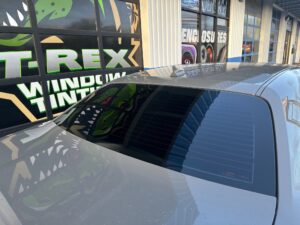




At Audio Designs & Custom Graphics, we are committed to providing top-tier service and quality results for every project we undertake. Recently, we had the privilege of enhancing a 2023 Dodge Challenger 392 Scat Pack for a Navy veteran who sought the best heat rejection for her vehicle. The dealership had installed a basic window film that provided minimal protection from the sun’s heat, leaving her car uncomfortably warm. To address this, we removed the inferior film, cleaned off all residual adhesive, and installed our high-end ceramic infrared (IR) window film, designed to block significant amounts of heat.
Additionally, we tinted the tail lights, giving the Challenger an aggressive, custom look that perfectly complemented its bold design. Here’s how we transformed this impressive vehicle into a more comfortable, stylish ride.
Why High-Quality Window Film Matters
Choosing the right window film for your vehicle is essential for both comfort and protection. Many dealerships install basic or low-quality films that offer little more than a darkened appearance but fail to block heat effectively. The 2023 Dodge Challenger 392 Scat Pack we worked on had this issue. Although the existing tint darkened the windows, it didn’t prevent the interior from becoming hot under the sun, which was a major concern for our client.
This is where high-performance ceramic IR films make a significant difference. Unlike traditional dyed films, ceramic films block substantial amounts of heat-producing infrared rays and harmful UV radiation without compromising visibility. Our client needed the highest level of heat rejection possible, so we recommended and installed our premium ceramic IR film on all windows, including the windshield and sunroof.
Removing the Old Film
The first step in this transformation was to strip away the low-quality film installed by the dealership. Removing old film is a meticulous process that requires care to prevent damage to the glass or defroster lines. Adhesive left behind from low-grade tints can be tricky to remove, but our team at Audio Designs & Custom Graphics has the experience and tools to handle it. We carefully cleaned off all residual glue, leaving the glass spotless and ready for the new film.
Once the old film and adhesive were completely removed, we were ready to apply the high-performance ceramic IR film, dramatically improving both the look and functionality of the vehicle.
Installing Ceramic IR Window Film
For this Dodge Challenger, we installed our premium ceramic IR film, which provides superior heat rejection, UV protection, and durability. On the side and rear windows, we applied a 5% tint, offering a sleek, private appearance while blocking the sun’s rays from entering the vehicle. This level of darkness not only enhances the car’s aggressive aesthetic but also delivers excellent privacy and heat control.
For the windshield and sunroof, we installed a 35% tint. Often overlooked, these areas play a critical role in heat management. Without tinting, they allow significant amounts of heat into the vehicle, making it harder for the air conditioning to keep the cabin cool.
The Benefits of Tinting the Windshield
The windshield is the largest glass surface on most vehicles and is constantly exposed to the sun’s rays. Without a high-performance film, heat entering through the windshield can make the cabin uncomfortable, especially during hot summer months. That’s why we installed a 35% ceramic IR film on the windshield of this Dodge Challenger. The ceramic film blocks up to 50% of infrared light and more than 99% of harmful UV rays, reducing interior heat while maintaining clear visibility.
By tinting the windshield, we improved the vehicle’s comfort, reduced strain on the air conditioning system, and protected the dashboard and interior materials from UV damage.
The Importance of Sunroof Tinting
Sunroofs are another often-overlooked area when it comes to window tinting. While they add an element of luxury and openness, they also allow significant heat to enter. For this Challenger, the factory-installed sunroof was allowing too much sunlight and heat into the car, making the interior uncomfortable.
We applied a 35% ceramic film to the sunroof, drastically reducing the amount of heat entering the vehicle. This film not only blocks infrared heat but also reduces glare, enhancing the overall driving experience. With the sunroof tinted, the entire interior stays cooler, offering a more comfortable ride even on sunny days.
Customizing the Tail Lights
In addition to window tinting, our client requested a blackout for the tail lights to create a more customized look. Tinting the tail lights gives vehicles a sleek, aggressive appearance and complements the overall aesthetic, especially on performance models like the Dodge Challenger 392 Scat Pack.
Tinting tail lights requires precision to ensure smooth adhesion while maintaining sufficient light transmission for safety. At Audio Designs & Custom Graphics, we use high-quality, durable film specifically designed for tail lights, ensuring a clean, professional look that enhances the car’s appearance while keeping it road-legal and safe.
Why Our Client Chose Audio Designs & Custom Graphics
Our client, a Navy veteran, knew exactly what she needed: superior heat rejection and protection for her car. Living in a warm climate, she experienced firsthand how quickly a vehicle can heat up under the sun. The dealership’s tint wasn’t cutting it, so she turned to us for a better solution. After discussing her needs, we recommended our ceramic IR film, offering the best protection against heat and UV rays.
The difference was noticeable immediately. After the installation, the interior of her Challenger was significantly cooler, even on sunny days, and the air conditioning system didn’t need to work nearly as hard. Additionally, the 5% tint on the side and rear windows provided the privacy she wanted, while the 35% tint on the windshield and sunroof delivered heat rejection without sacrificing visibility.
Why Choose Ceramic IR Film?
Ceramic IR film is the top choice for anyone seeking superior heat rejection and UV protection. Unlike regular dyed films, ceramic films block up to 90% of infrared heat, making a huge difference in interior comfort during hot weather. Some key benefits of ceramic IR films include:
Conclusion







